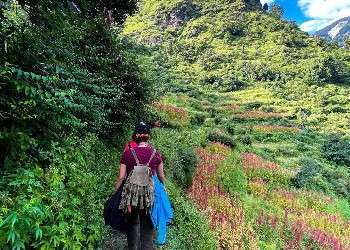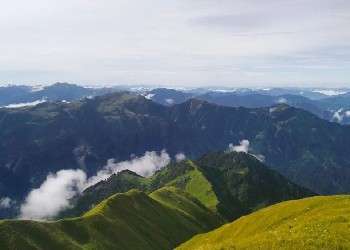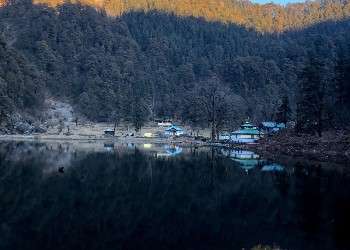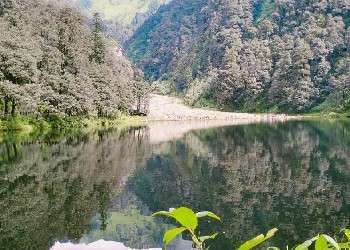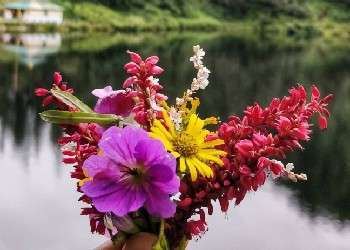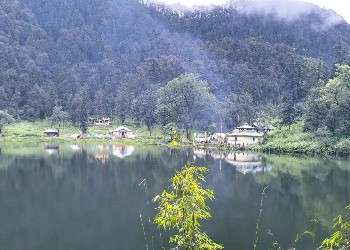DODITAL TREK ---
THE TRULY ALLURING LAKE
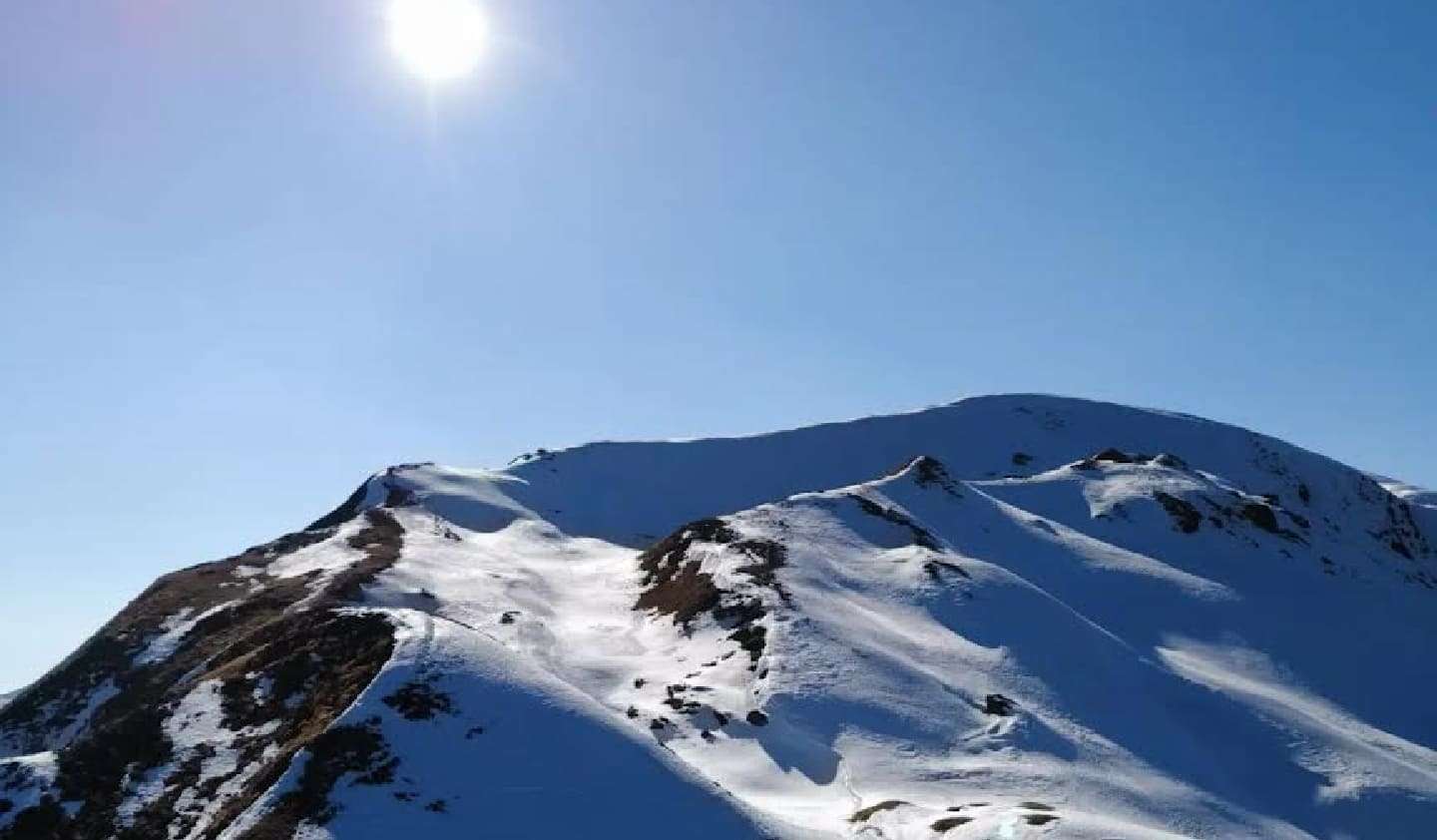
Trek Cost :
₹ 10,000 + 5% GST (Dehradun to Dehradun)
ABOUT THIS TREK
Grade : Easy
Region : Uttarakhand
Altitude : 4150 m
Trek Distance : 40 Km
Trek Days : 6 Days
Best Season : March to August
Nearest Railway : Dehradun
Nearest Airport : Jolly Grant
Dodital a fresh water lake located in the Uttarkashi district of Uttarakhand, at the altitude of 3024 meters/9921 ft. The Assi-Ganga river originated from here & feeds Bhagirathi
river at Gangori, near Uttarkashi. Since Doditaal is a offbeat & less footed trek till now, the beauty and peaceness on this trek are still a reward for you. This trek is named after
a rare Himalayan fish, Trout which is called as Dodi in local languages. This trek offers you undistrubbed an unmatched campsites, the camp at Behbra is near a rivulet that will give
you a pure smell of Himalayan adventure nature. Trek through the mixed forest of Pine, Oak, Deodar, Rhododendron forest. Soak in the beauty of the lonely calm lake with few birds
chattering nearby.
This place is known for the birth place of Lord Ganesh, has very dramatic terrain of forests, scenic rivers, smooth grass fileds and obviously snow capped himlayan peaks. The route
from Doditaal to Darwa Top opens up with very stunning views of surroundings. Come across with the Dhauladhar and greater himalayan range. Witness the nonstop view of distant valleys
and himalayan forest. The train thorugh the meadows are another level of refreshments.
The trek starts from the little village Sangam Chatti in Uttarkashi. On the first day experience the Agoda settlements. And on the way capture the settlements of Gujjars leading to
DOditaal. Make way through the dusted snow, see the tall pine trees and witness the inspiring views of the mountains. Trek though varient forest and open meadows. Experience the
Golden Masheer, one of the himnlayan fish in the freshwater lake is very thrilling at that altitude.
This all makes this trek very attracting for trekkers who wants to have a different taste from over crowded treks like Kedarkantha. Spend some times in the peaceful himalayas, find
your own solitude.
WHY YOU SHOULD DO THIS TREK
Dodital
Dodital is the a medium fresh water lake, inside the thick forest of pine, oak, ceder, Rhododendron trees. The emrald lake is formed by the accumulation of natural streams coming
from the uphill. The calm nature of Dodital definately make you fall in love with himalayan flora.
A Ganesh Temple
A Ganesh Temple is there just beside the lake. Visit the Temple feel the spirituality. Or you can meditate there for a while.
Green & Green
Dodital is an eye soothing green in the season of Spring and Summer. The green velvet grasses below your foot & green surrounding is so pleasant that you surely forget about
your normal daily life. Capture some greemn memories, lay down on the grass take some fresh breath in himalayan atmosphere.
Wide open valley
On the every day trek trail you will witness a larger than life wide valleys with lots of trees. The wide valleys offer long range views.
ITINERARY
DAY 1 | Arrive Agoda village
You are expected to arrive Agoda Village by evening. Drive from Dehradun to Agoda Village through narrow Bhagirathi river valley. 154 kms, 6/7 hrs. 16 kms from Uttarkashi. Reach by
evening meet our Guide/Trek Leader, a short briefing seasson will be there with evevning tea & snacks. Later have delicious dinner. Overnight stay at homestay.
Altitude : 2250 m
Altitude : 2250 m
DAY 2 | Agoda Village to Manjhi
After breakfast start your adventure to our first campsite Manjhi, 8kms, 4/5 hrs. Trek through the gradual trail to Manjhi. Reach by lunch time & have lunch. We will take a
acclimatisation walk followed by evening tea & snacks. Dinner will be served at campsite, overnight stay at tents.
Altitude : 2880 m
Altitude : 2880 m
DAY 3 | Manjhi to Dodital
Wake up in the lap of the Himalayas. After healthy breakfast start trek, 7 kms, 4/5 hours. A bit more challenging day than before. Lunch at the campsite. Have a peacefull afternoon
walk followed by evening tea & snacks. Later a delicious dinner. Overnight stay at campsite.
Altitude: 3000 m
Altitude: 3000 m
DAY 4 | Darwa Top excursion
We will start after a delightful breakfast in the morning to catch the glimpses of Himalayas from Darwa Top. Have the most thrilling view from the top, capture some unforgottable
moments. Spend few times on the top, I swear that you don’t want to come back. Feel every moment with jaw dropping views. Get back to the campsite.
Altitude: 4100 m
Altitude: 4100 m
DAY 5 | Dodital to Agoda Village
Trek directly back to the Agoda village, all easy descent route, 15 kms, 7/8 hrs. Reach our Homestay by afternoon with pocket full of memories. Rest at Agoda village for today.
Altitude: 2250 m
Altitude: 2250 m
DAY 6 | Agoda Village to Dehradun
After the breakfast depart for Dehradun, 7/8 hours journey. You will reach Dehradun by evening, book your stay and tickets accordingly.
HOW TO REACH THE BASE VILLAGE AGODA
Based on your request we can arrange a cab from Dehradun to Agoda Village, the cost will be shared equally by the trekkers. This cost is not included in the trek cost. A 6/7 seater
cab will cost you 5000 and a tempo traveller can cost you 8000 wich can accomodate 12/13 members. The members who wants to reach the trek base on your own, there are bus service from
Dehradun/Haridwar to Uttarkashi. The Uttarakhand govt buses ply regularly, a bus from Deheadun depart at 8:00 AM is best option to reach Uttarkashi. After a quick lunch at Uttarkashi
get the shared vehicle for Agoda Village from the main taxi stand few minutes walk from bus stand. If there is no direct cab for Agoda village you can take cab till Sangam Chatti.
From there Agoda village is only 6 kms. Get back to Dehradun by same way. If you find still this confusing, feel free to contact us.
FINEST TIME TO EXPERIENCE
Dodital is a truly round the year trek. Even in monsoon when all the treks in Uttrakhand prohibited, Dodital remains open to the adventure enthusiast. But if you want to experience
the best of Doditaal, you need to book on Spring & Summer. Spring offers both green and few snows at the higher altitude, which is a mixture of varient views and beauty. While summer
is for pure green lovers. The weather remains very pleasantful in this two season. Otherwise you can also do this trek in Autumn also, The fall offers more clear views than Summer haze.
But all the trail wiill be like yellow-brown color with dry mountain shrubs and grasses.
This trek becomes a true heaven in winter. The lots of people just rush towads Kedarkantha in winter unnecessarily, making the trail over crowded. So, don’t run in the rat race, be
eceptional at Doditaal. Doditaal also offers a best white fairy land in winter. All the trail with snow and the snow beside the lake make it picture perfect. Like Kedarkantha there
will be a summit experience at Darwa Top also. So, it is still a mystry that why people still not find this trek as winter trek. Believe us the winter is a unparalleled beauty at
Doditaal trek. It will not give any chance to regret to choose as a winter trek. It has all kind of beauty and adventurous in winter also.
HOW DIFFICULT IS THIS TREK
This is another trek in the himalayas which offers beginners and also kids above 14 years of age. So, you can imagine at your won how difficult the trek is. After considering all
the factors like altitude, terrain, distance, number of campsites this trek is graded as easy from our experienced trek team. The gradient of steepness of the trails are not so
much challenging, that a kid can aslo do this trek. As the highest altitude of Darwa Top is 4150 meters and we spent an hour only above 4000 meters the risk of altitude sickness is
very less. This beginner level trek is must do trek in Uttarakhand. It is suggested to do this trek with your family also (need to be fit enough).
TREK INCLUSIONS
- Stay included from Day 1 to Day 5. Homestay/Tents are included on sharing basis.
- All meals after reporting at the base village Agoda are included.
- All camping gears are included.
- A medical kit, oxygen cylinder and necessary items to counter worst case scenario.
- A certified Trek Leader, well trained and experienced Guide, Co-guide(if necessary) are included.
- All the forest permission and entry permit are included.
- Pickup & drop transportation.
TREK EXCLUSIONS
- Any meals on road journeys.
- Personal hiking gears.
- Separate room for couples (charges apply if booked prior).
- Porter or mules for carrying personal luggeages.
- Any personal expenses on shops/dhabas.
- Any unscheduled stay/departure out of the itinerary due to unforeseen weather conditions, govt ban, natural calamities, medical emergencies.
WHAT TO CARRY ON DODITAL TREK
The beginner friendly Dodital trek doesn’t demand a lot from you. But the first thing you need to carry on every trek is a bit fitness and endurance. So before attempting
a trek always do some Cardio and other endurance exercises to build your exercise. And oviously few hiking gears like Rucksack, Waterproof Trekking shoes, warm layers of Jackets,
Thermal Inners, Woolen and sun caps, Sunscreen(SPF 40) and toileteries, good quality waterbottle, multiple pair of socks, lighyt wieght rain poncho or jacket, warm gloves, a day pack
Headlamps with extra cells, sunglasses etc. At last if you have any queries or its confusing what to carry for you, please feel free to contact Adventure Now. Don’t overwaight your
backpack, otherwise trek will seem to be very difficult.
IS THIS TREK SAFE FOR CHILDERN?
This trek is not just safe for the kids, this is a trek for the kids. Yes, introduce your child a great himalayan adventure with this trek. This trek doesn’t need any trek experience
before. As the number of campsites are only 3, it will be perfect for your child to spend maximum three days at camps. The trails is mostly gradual, very few steep uphill. And lastly
our experienced Guide and Trek Leader will be there to ensure all kind of safety of your child. Don’t worry to much, give them a open world that will make them a strong personality.
Frequently Asked Questions
Acclimatisation is the most important part of high altitude trek. Acclimatisation is the process where your body start getting cope up with mountain weather & atmosphere that is
different from your hometown. This change of environment may affect your normal performance in that environmental conditions. So you need to be well acclimatise to safely do the
trek. Not every time depend on the high altitude medicines to avoid AMS, go for natural acclimatisation. Otherwise your body will depend permanently on the medicines whenever you
go to the high altitude. The natural acclimatisation is more powerful than medicines. We need to accept the himalayas as it is challenging. It is not that himalayas are unbeatable,
but requires to follow rules and systematic approch.
How do human body actually acclimatise to the high altitude? In the high altitude the air pressure gets lower so the density. That is why the molecules spreads out in more space and
get apart from each other. This affects lower oxygen consume per breath. Our body reacts with that change and starts to take more breath that is hypoxia. We often called it
breathlessness in laymen term. Then body try to take more breath to reduce the level of carbon dioxide in our blood. This results increase pH of blood, making our blood more alkaline
and body starts urinate more for exerting of bicarbonates.
On the other side the body starts to produce more hemoglobin count which are the oxygen carriers in our blood. This thickens our bloods and now our heart need to pump more to throw
the blood in the distant organs hence the blood pressure gets higher. This indicates slight high pressure and pulse rate is normal in high altitude areas.
There are three golden rules to acclimatisation in the field of mountaineering is –
1. Climb high sleep low
2. Ascend slowly, take your time. And do not over exert.
3. Hydrate & hydrate yourself more & more.
Our expert justified few ways to acclimatise naturally are discussed below-
At first check your itinerary. Trekking is not a game in hurry. You need time to complete. It is not anything you achieve but enjoyed. This is a sport that is away from any competition. Any trek should not be judge by time & distance. Do not over exert yourself, don’t go beyond your limits. Fix your itinerary comfortably. Do not try to cover more distance and altitude gain in one day to minimize the trekking days and cost. On the very initial days approach slowly even you are fit enough to trek faster. Take more time to gain altitude. This allows your body enough time to adjust with the atmosphere. Always bring a well hydrated body in the Himalayas and keep hydrated yourself on the trek days. Drink 3-4 liters of water every day on trek, and consume enough tea, soup, dal and other liquid includes in your meals. Do not consume any type of alcohol drinks 2/3 days before you start the trek, and also don’t on the trek. We do not allow any trekker to consume alcohol on the trek, if found he/she will be sent back then and there. We do not also advise to consume any hard drinks, too much coffee is also not good. ORS and other energy/glucose tablets are best on the trek. After arriving on trek base, trekkers may feel cold weather. But do not cover yourself fully with all of the woolen cap, muffler, neck warmer and all. Let your body to sense the atmosphere change with the sense organs. It will help in natural acclimatisation. Allow your skin to feel the cold. your ears to sense the pressure change. Keep that open while gaining altitude, unless there is a blizzard or bad weather condition. Don’t be a show off man, don’t show unnecessary bravery. Keep your body protect from cold weather. Protect your body from cold wind, cover your head at night & bad weather, cover your neck, tonsils and body tip like fingers, toes etc. Get proper sleep at night. It doesn’t mean that you should sleep at day time or in the afternoon as soon as you reach the campsite. Sleeping is important on every trek to get refresh and rest for next day trek. If you find difficulty in sleep bring immediate notice to the trek leader or guide. As you reach the trek base try to keep yourself dry, do not loose the body heat. Do not skip your soup in the evening. The garlic soup & other helps in blood circulation, keeps your body warm. You remain active on the high altitude. After reaching campsite everybody gets tired, this is normal. But do not get into your sleeping bag & take a nap. This will not help you to get acclimatise. Have some rest for a while, then explore the nearby places, go for the acclimatisation walk. You need to follow the golden rule ‘climb high sleep low’. Climb a bit higher in acclimatisation walk and get back to the campsite. You can indulge yourself in games, or can go for photography. Eat proper meals throughout the day, but lite. Not so much spicy foods, consume easy to digest foods more.
1. Climb high sleep low
2. Ascend slowly, take your time. And do not over exert.
3. Hydrate & hydrate yourself more & more.
Our expert justified few ways to acclimatise naturally are discussed below-
At first check your itinerary. Trekking is not a game in hurry. You need time to complete. It is not anything you achieve but enjoyed. This is a sport that is away from any competition. Any trek should not be judge by time & distance. Do not over exert yourself, don’t go beyond your limits. Fix your itinerary comfortably. Do not try to cover more distance and altitude gain in one day to minimize the trekking days and cost. On the very initial days approach slowly even you are fit enough to trek faster. Take more time to gain altitude. This allows your body enough time to adjust with the atmosphere. Always bring a well hydrated body in the Himalayas and keep hydrated yourself on the trek days. Drink 3-4 liters of water every day on trek, and consume enough tea, soup, dal and other liquid includes in your meals. Do not consume any type of alcohol drinks 2/3 days before you start the trek, and also don’t on the trek. We do not allow any trekker to consume alcohol on the trek, if found he/she will be sent back then and there. We do not also advise to consume any hard drinks, too much coffee is also not good. ORS and other energy/glucose tablets are best on the trek. After arriving on trek base, trekkers may feel cold weather. But do not cover yourself fully with all of the woolen cap, muffler, neck warmer and all. Let your body to sense the atmosphere change with the sense organs. It will help in natural acclimatisation. Allow your skin to feel the cold. your ears to sense the pressure change. Keep that open while gaining altitude, unless there is a blizzard or bad weather condition. Don’t be a show off man, don’t show unnecessary bravery. Keep your body protect from cold weather. Protect your body from cold wind, cover your head at night & bad weather, cover your neck, tonsils and body tip like fingers, toes etc. Get proper sleep at night. It doesn’t mean that you should sleep at day time or in the afternoon as soon as you reach the campsite. Sleeping is important on every trek to get refresh and rest for next day trek. If you find difficulty in sleep bring immediate notice to the trek leader or guide. As you reach the trek base try to keep yourself dry, do not loose the body heat. Do not skip your soup in the evening. The garlic soup & other helps in blood circulation, keeps your body warm. You remain active on the high altitude. After reaching campsite everybody gets tired, this is normal. But do not get into your sleeping bag & take a nap. This will not help you to get acclimatise. Have some rest for a while, then explore the nearby places, go for the acclimatisation walk. You need to follow the golden rule ‘climb high sleep low’. Climb a bit higher in acclimatisation walk and get back to the campsite. You can indulge yourself in games, or can go for photography. Eat proper meals throughout the day, but lite. Not so much spicy foods, consume easy to digest foods more.
Trekking is a adventure sports, you need to bring a sportsman sprit and fitness on any trek. There is a big worry in many trekkers that how much they need to be fit for a trek.
The himalayas are full of steep uphill, rough terrain, walking in the snow all these can be very challenging for trekkers specially for beginners. We will discuss here how to get fit
for any trek with a complete training guide.
Trek to uphill mountain is not in our daily routine so it is simple that we will find it tough to climb uphill. And with a backpack it seems very challenging. But only a month of
regular exercise can make you fit for the trek. Cardio exercise is the best for pre trek exercise. Do some cardio exercise like jogging, swimming, cycling, jumping jacks etc will help
you to build your endurance. Don’t forget to do some leg exercise like squats, lunges, stair climbing etc to build stamina of your legs.
Now we made a routine exercise for you –
1. Cardiovascular endurance : On your trek you will constantly gaining altitude with your backpack in low oxygen atmosphere. Your heart will do more effort in this condition. So you need to go through cardio exercise at least for one month regularly to counter this constant uphill climb comfortably, infact you will find it bit easier. Jogging for 4 kms in 30 minutes is your first target for this. Start with slower jog and continue to fill the target.
2. Leg exercise : After one week of jogging add some leg exercise like squats and lunges to your routine. This exercises will build stamina of your leg that will help you on steep uphill climb. Start with 10 squats and 10 lunges of 2 set in first week. Then increase to 3 sets. Try to fulfil your target to do 3 sets of 15 each before the trek.
3. Strengthening the core : For strengthening your core body plank and hip raise are best. Do plank for 20 seconds for first three days and then start increasing by 10 seconds till 60.
Along with that do 10 hip raises 2 sets, and increase for 3 sets of 15 each. That should be the goal. So, get ready for your next adventure, make yourself fit enough to do the adventure activities.
There are three level of fitness we categorise :
Level 1 : It is the minimal fitness with that you just able to finish the trek. You struggle a bit, but not too much to do the challenging section. We find most of the trekkers with this much of fitness.
Level 2 : This is one level up fitness you bring on the trek, that you find the trek not very difficult or moderate but easy. And you can carry your own backpack easily throughout the trek. You don’t feel exhausted at the end of every day trek. You are find yourself still not tired and active after reaching the destination. You enjoy the other activity and enjoy exploring the nearby or involving yourself in some game.
Level 3 : This is the fitness we admire most & the ultimate mountaineer like fitness. The trekkers with this fitness finds trek easy for them and they are still very active after the whole day trek even with their rucksack. Not only that these people are fit enough to tolerate bad weather conditions, contribute in some work like tent pitching & kitchen activity, bringing water from nearby water source. Give a hand if other trekkers are in trouble or in some rescue operation.
1. Cardiovascular endurance : On your trek you will constantly gaining altitude with your backpack in low oxygen atmosphere. Your heart will do more effort in this condition. So you need to go through cardio exercise at least for one month regularly to counter this constant uphill climb comfortably, infact you will find it bit easier. Jogging for 4 kms in 30 minutes is your first target for this. Start with slower jog and continue to fill the target.
2. Leg exercise : After one week of jogging add some leg exercise like squats and lunges to your routine. This exercises will build stamina of your leg that will help you on steep uphill climb. Start with 10 squats and 10 lunges of 2 set in first week. Then increase to 3 sets. Try to fulfil your target to do 3 sets of 15 each before the trek.
3. Strengthening the core : For strengthening your core body plank and hip raise are best. Do plank for 20 seconds for first three days and then start increasing by 10 seconds till 60.
Along with that do 10 hip raises 2 sets, and increase for 3 sets of 15 each. That should be the goal. So, get ready for your next adventure, make yourself fit enough to do the adventure activities.
There are three level of fitness we categorise :
Level 1 : It is the minimal fitness with that you just able to finish the trek. You struggle a bit, but not too much to do the challenging section. We find most of the trekkers with this much of fitness.
Level 2 : This is one level up fitness you bring on the trek, that you find the trek not very difficult or moderate but easy. And you can carry your own backpack easily throughout the trek. You don’t feel exhausted at the end of every day trek. You are find yourself still not tired and active after reaching the destination. You enjoy the other activity and enjoy exploring the nearby or involving yourself in some game.
Level 3 : This is the fitness we admire most & the ultimate mountaineer like fitness. The trekkers with this fitness finds trek easy for them and they are still very active after the whole day trek even with their rucksack. Not only that these people are fit enough to tolerate bad weather conditions, contribute in some work like tent pitching & kitchen activity, bringing water from nearby water source. Give a hand if other trekkers are in trouble or in some rescue operation.
Rucksack is a most important equipment on every trek & packing your rucksack is a important task for your trek. On a typical trek you need to carry your own rucksack, and if your
rucksack is not comfortable to carry you will eventually start hating your backpack and also the trek. A rucksack need to be perfectly pack that it should be comfortable to carry
on your back. It should not hurt you anyhow. The mordern day designed rucksacks are very light weight and have many chambers to pack seprately. A good quality rucksack have well
paded for comfortable carrying in waist and shoulder. If you are planning to buy a rucksack, please keep the things in your mind and don’t forget to check the strength of rucksack and
other straps.
Before you pack your rucksack go through our basic rule. This will help you to pack easily as a beginner. You just can not do every day packing and unpacking on multiple day of trek. Imagine how irritable and time consuming that will be. The A B C D E rule to pack your rucksack—
A – Accessibility = While packing your rucksack pack in such way that every thing are easily accissible for you. Use the different parts to achieve different things easily. For an example use different chambers for toileteries, different for your dry fruits and snacks, different for clothes, different for small items like gloves, socks, woolen caps etc. Keep the items at top or side pockets that you may need on the way like rain wears, sunglass, sunscreen etc.
B – Balance = Your bag need to be packed in such way that it can stand straight when you leave your backpack alone on a flat surface. The more your backpack is balanced the less it will hurt your shoulder. The weight distribution on both shoulder should be equal in order to comfortable carry.
C – Compression & Compartments = While packing your backpack compress all the cloths and the things that can be compresed. It will give you more space inside your rucksack. But remember don’t do more compress or less, do as much as it needed. Compress till it gives you more space to adjust other things. Now use more compartments or make more compartments by using different colored plastic bags, like for socks and underwear use red color plastic bags, for inner and thermal clother use yellow bag, for woolen cap & gloves use green one. It will not only give you another layer of waterproofing but also help you recognise all the different things. This will also help you to find your stuffs quickly.
D – Dry = Always keep your backpack dry from outside and inside also. Use rain cover from outside. And from inside all of your stuffs should be kept dry, otherwaise it will be more heavier than usual. Wet rucksack is not only heavier but also prone to damage, not good for rucksack maintenance. Use rain cover to protect from get wet.
E – Environment = Make a list of your stuffs that need to be packed inside the rucksack according to the environment of the trek you are going. Keep in mind the weather in that perticular month you choose to trek. Pack your backpack with stuffs you need in that weather conditions.
EXPERT’S ADVISE:
-> Always keep the heavy things in the middle of the rucksack and closer to your back.
-> The medium weight things should be kept in the lower compartments & liteweight items should be kept in top section of your rucksack.
-> Use plastic layer from inside to keep the stuffs dry.
-> Don’t forget to put rain cover from outside in rain and snow.
-> Adjust the shoulder straps to balance weight on both shoulder. Put the waist starps also to get better support and balance.
-> You can use you rucksack as a pillow inside the tent, or can rest your leg on rucksack.
Before you pack your rucksack go through our basic rule. This will help you to pack easily as a beginner. You just can not do every day packing and unpacking on multiple day of trek. Imagine how irritable and time consuming that will be. The A B C D E rule to pack your rucksack—
A – Accessibility = While packing your rucksack pack in such way that every thing are easily accissible for you. Use the different parts to achieve different things easily. For an example use different chambers for toileteries, different for your dry fruits and snacks, different for clothes, different for small items like gloves, socks, woolen caps etc. Keep the items at top or side pockets that you may need on the way like rain wears, sunglass, sunscreen etc.
B – Balance = Your bag need to be packed in such way that it can stand straight when you leave your backpack alone on a flat surface. The more your backpack is balanced the less it will hurt your shoulder. The weight distribution on both shoulder should be equal in order to comfortable carry.
C – Compression & Compartments = While packing your backpack compress all the cloths and the things that can be compresed. It will give you more space inside your rucksack. But remember don’t do more compress or less, do as much as it needed. Compress till it gives you more space to adjust other things. Now use more compartments or make more compartments by using different colored plastic bags, like for socks and underwear use red color plastic bags, for inner and thermal clother use yellow bag, for woolen cap & gloves use green one. It will not only give you another layer of waterproofing but also help you recognise all the different things. This will also help you to find your stuffs quickly.
D – Dry = Always keep your backpack dry from outside and inside also. Use rain cover from outside. And from inside all of your stuffs should be kept dry, otherwaise it will be more heavier than usual. Wet rucksack is not only heavier but also prone to damage, not good for rucksack maintenance. Use rain cover to protect from get wet.
E – Environment = Make a list of your stuffs that need to be packed inside the rucksack according to the environment of the trek you are going. Keep in mind the weather in that perticular month you choose to trek. Pack your backpack with stuffs you need in that weather conditions.
EXPERT’S ADVISE:
-> Always keep the heavy things in the middle of the rucksack and closer to your back.
-> The medium weight things should be kept in the lower compartments & liteweight items should be kept in top section of your rucksack.
-> Use plastic layer from inside to keep the stuffs dry.
-> Don’t forget to put rain cover from outside in rain and snow.
-> Adjust the shoulder straps to balance weight on both shoulder. Put the waist starps also to get better support and balance.
-> You can use you rucksack as a pillow inside the tent, or can rest your leg on rucksack.
Lots of trekkers are very worried about their accomodation on trek days. Wheather it gonna be comfortable or not, safe or not. Here is the answer. We have the good quality tents and
sleeping bags for high altitude treks. Our mattress are very soft and thick to provide a comfortable sleep at night. But you should keep in mind that trekking in wilderness in himalayas
are not any four or five star category. This is an adventure trip, if we provide a homely/hotel feeling on your trek, then there will be no adventure left for you. But obviously
we will definitely provide a safe and cozy tent for your stay. Our tents are tested in bad weather conditions also. Sleeping bags are very warm to spend nights with a good sleep.
And at the trek bases we arrange the best homestay available at the village. Homestays are sanitised and clean from inside. Toilets are well maintained and hygiene.
We go to the each and every trek base we organise and choose our guides on the basis of their experience, behaviour, past record, knowledge, abilities and good personality. They
knows all about the routes and reacue & evacuation plans. They know how to handle in bad weather conditions. Our guides are well trained for work in the mountains, knows about
the camping gears. They have years of experience in safety methods and protocols on the trek. Our guides are very happy to help and eager to serve you better. They always maintain
health and hygiene. They are very friendly and make the more enjoyable for you.














